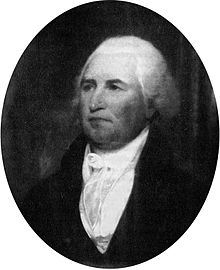Edward Bancroft (chemist)
Edward Bancroft (born January 20, 1744 in Westfield (Massachusetts) , † September 8, 1821 in Margate (Kent) , England ) was a British chemist, doctor and naturalist, known for his contributions to the dye industry. In the American Revolutionary War he was a double agent for the British and Americans.
Bancroft lost his father at an early age, grew up in Connecticut and was apprenticed to a doctor in Killingworth (Connecticut ), but left this after a few years. From 1763 to 1766 he was a plantation doctor in Dutch Guyana, where he also conducted natural research. He was one of the first to investigate the curare arrow poison and discovered that electric eels paralyze their prey with electricity. With publications about it and a book that appeared in London in 1769, he gained a reputation as a scientist with Benjamin Franklin, among others . In the 1760s he worked in England with dyes and calico printing. In 1770 he was looking for dyes in North and South America (and to inspect a plantation in Suriname on behalf of an Englishman) and after returning to England he introduced the bark of the dyer's oak as a dye supplier in England. After the American Revolution, he imported the bark of the yellow oak from America to England and became wealthy. In 1794 he published the first handbook in England on the chemistry of dyes (Experimental researches concerning the philosophy of permanent colors and the best method of producing them by dyeing, Calico-printing etc.). He divided dyes into substantive (without a mordant, e.g. indigo, purple) and adjective dyes that needed a mordant. He mistakenly believed oxygen was an essential part of the dyeing process.
During the American War of Independence he was a double agent for both the Americans and the English. In 1776, through Franklin's mediation, he was called in to secret negotiations between the Americans and the French in Paris under Silas Deane. Deane was his former teacher in Connecticut. He then spied for the Americans in Great Britain. After returning to London, however, he revealed himself to the English and became a double agent. He informed the English about the status of Benjamin Franklin's negotiations in Paris, which led to the Franco-American alliance. His double agent activity remained hidden from the Americans and only came to light in 1891 when the British diplomatic archives were opened.
In 1771 he married in England. The marriage had seven children.
In 1797 he became an honorary foreign member of the American Academy of Arts and Sciences .
Fonts
- An Essay on the Natural History of Guiana, in South America, London 1769
literature
- Winfried R. Pötsch (lead), Annelore Fischer, Wolfgang Müller: Lexicon of important chemists , Harri Deutsch 1989, p. 26.
Web links
| personal data | |
|---|---|
| SURNAME | Bancroft, Edward |
| BRIEF DESCRIPTION | British physician, chemist and naturalist |
| DATE OF BIRTH | January 20, 1744 |
| PLACE OF BIRTH | Westfield, Massachusetts |
| DATE OF DEATH | September 8, 1821 |
| Place of death | Margate (Kent) |
